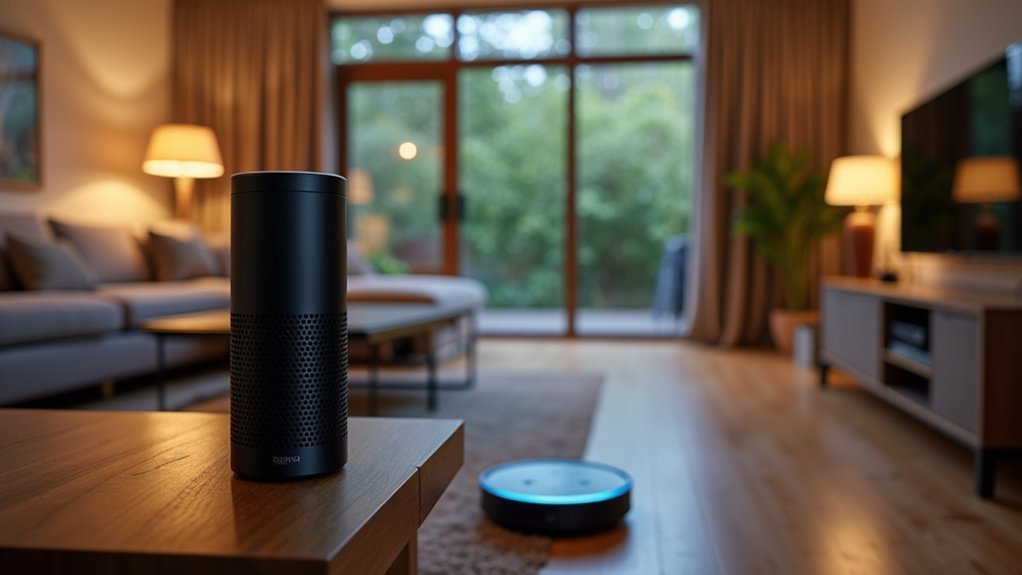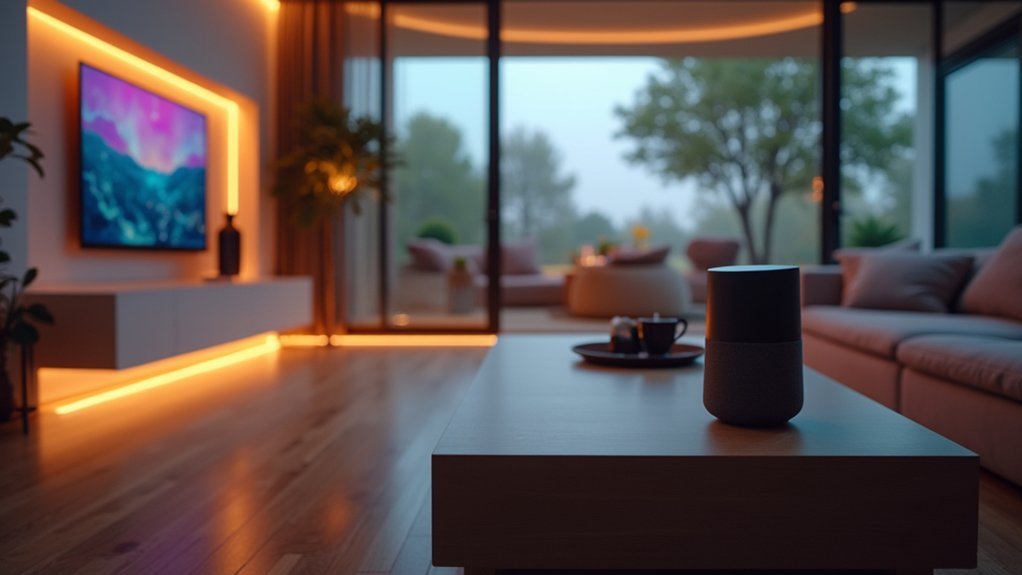Voice assistants transform your home into a responsive smart ecosystem through simple commands. Amazon Alexa+ leads with extensive third-party compatibility, while Google Assistant offers versatile AI control across devices. Apple’s Siri prioritizes privacy, Microsoft Copilot enhances productivity, and enterprise solutions like PolyAI and Spitch provide advanced management capabilities. You’ll also find platforms specializing in multi-step automation routines that execute several actions simultaneously. Discover which assistant best aligns with your smart home vision and lifestyle needs.
Amazon Alexa+: The Smart Home Ecosystem Leader

While Amazon Echo once dominated 80% of the smart speaker market in 2017, Alexa now maintains a 25-30% share in an increasingly competitive landscape.
Despite this shift, you’ll find Alexa remains at the forefront of home automation technology.
With integration capabilities spanning 100,000+ third-party devices, you can control everything from Philips Hue lighting to Ring security systems with simple voice commands.
Alexa’s AI learns your preferences and habits, enabling personalized responses and automated routines for wake-up sequences or movie nights.
As smart home adoption approaches 77.6% of households by 2025, Alexa’s ecosystem continues expanding its functionality through Skills and deeper device integration. This growth aligns with projections that the global smart speaker market will reach USD 57.48 billion by 2033.
Even as competition from Google and Apple intensifies, Alexa’s advanced natural language processing and vast device compatibility keep it leading the automation revolution.
Google Assistant: Versatile AI Control Across Devices
Google Assistant stands at the intersection of three critical smart home capabilities: seamless device integration, intelligent automation, and personalized experiences.
You’ll benefit from its extensive compatibility with Google Nest products, smart appliances, and countless third-party devices.
With advanced AI learning, your Assistant adapts to your preferences across the ecosystem, making increasingly relevant suggestions based on your habits.
Your smart home evolves with you as Assistant’s AI learns your preferences and anticipates your needs through habit-based suggestions.
You can create sophisticated routines that trigger multiple actions with a single command like “Good morning” or “Movie night.” The affordably priced Google Nest Mini offers excellent functionality for those just starting with smart home voice control.
- Controls everything from lighting and thermostats to car navigation systems
- Executes complex routines that manage multiple devices simultaneously
- Switches languages mid-conversation for multilingual households
- Will soon offer predictive automation based on your behavioral patterns (2025)
Apple Siri: Secure HomeKit Integration for Privacy-Focused Users

As privacy concerns continue shaping smart home choices, Apple’s Siri offers a compelling alternative through its secure HomeKit integration.
You’ll control your entire home ecosystem through the Home app or voice commands, with everything syncing seamlessly across your iPhone, iPad, Apple Watch, and Mac.
HomeKit Secure Video encrypts your footage locally before uploading to iCloud, processing data on-device rather than in the cloud.
This approach gives you enhanced control over personal information while still enabling AI features like person detection and activity zones.
You can create sophisticated automation routines that trigger multiple devices simultaneously—locking doors, adjusting lights, and arming security when you leave home.
Compatible systems from Vivint, Abode, and SimpliSafe provide options ranging from DIY to professional monitoring, all accessible remotely with biometric authentication for extra security. Abode stands out as it’s been consistently recommended for over 5 years as the best smart home security system for Apple HomeKit.
Microsoft Copilot: Productivity Enhancement Beyond Basic Home Control
Microsoft Copilot takes voice assistance beyond simple smart home commands by integrating deeply within the Microsoft 365 ecosystem. Unlike traditional voice assistants, Copilot’s advanced AI capabilities enhance your productivity by automating complex tasks across your digital workspace.
With Copilot, you’ll experience:
- Seamless content generation – draft emails, create presentations, and generate reports using natural language commands
- Multi-app orchestration – direct AI to handle workflows across Word, Excel, PowerPoint, and Teams simultaneously
- Voice-activated system control – manage your Windows environment hands-free with contextual voice commands
- Intelligent data analysis – extract insights from spreadsheets and build complex models through simple spoken requests
Copilot’s integration with Microsoft Graph guarantees all your productivity tools work together, making it a powerful assistant that transforms how you work beyond basic home automation. The system employs sophisticated large language models to deliver personalized responses based on your accessible work content.
PolyAI: Enterprise-Grade Voice Commands for Advanced Setups

While traditional voice assistants focus on consumer needs, PolyAI delivers enterprise-grade voice command solutions specifically designed for sophisticated business environments.
Unlike consumer options, this system handles complex queries with human-like responses across multiple languages.
If you’re looking to integrate advanced voice automation into your home office or business setup, PolyAI offers robust integration with existing CRM systems and contact center technologies.
You’ll find its capabilities particularly valuable for industries like banking and healthcare.
Be prepared for enterprise-level pricing, with annual contracts starting around $150,000 for full deployments.
The system includes 24/7 emergency support and customization options to fit specific requirements.
For home automation enthusiasts seeking professional-grade voice control, PolyAI represents the upper tier of conversational AI technology.
The platform can efficiently handle workloads equivalent to what would normally require 50-95 full-time agents, making it an exceptionally powerful solution for business environments.
Spitch: Omnichannel Voice Control for Comprehensive Home Management
Spitch’s omnichannel platform lets you control your entire smart home ecosystem through a unified interface, regardless of device brand or communication method.
You’ll enjoy seamless voice command functionality across multiple languages, allowing everyone in your multilingual household to interact naturally with your home systems.
This cross-platform integration eliminates the frustration of juggling separate apps or remembering different command structures for each smart device in your network.
The platform leverages advanced NLU-powered technology similar to what enables their business CSAT surveys, ensuring your home understands exactly what you’re asking for.
Cross-Platform Device Integration
The future of smart home control lies in omnichannel voice systems that seamlessly unite multiple voice assistants under one management platform.
When integrating your smart devices across platforms, compatibility and interoperability become vital factors for success.
To guarantee your cross-platform voice control system functions at its best:
- Verify device compatibility with your chosen virtual assistants before purchasing to avoid integration headaches.
- Look for systems supporting standardized protocols like Zigbee, Z-Wave, or Matter to maximize device compatibility.
- Choose platforms with robust APIs that allow devices from different manufacturers to work together.
- Set up regular firmware updates to maintain compatibility as your smart home ecosystem expands.
This approach lets you control everything from lighting and security to entertainment systems through unified voice commands, regardless of device brand. Implementing solutions with local processing capabilities ensures your voice data remains private while eliminating network latency issues.
Multi-Language Command Support
Households with diverse language speakers can now enjoy inclusive smart home experiences through advanced multi-language command support.
You’ll benefit from virtual assistants that recognize and respond to voice commands in numerous languages with high precision, eliminating communication barriers in your home.
These systems use sophisticated natural language understanding (NLU) and large language models to instantly interpret your intent regardless of the language you speak.
You can seamlessly switch between languages or communication channels while maintaining context – start a request by voice in Spanish and continue by text in English without losing momentum.
Voice biometric authentication works across languages, ensuring secure access to sensitive home controls.
Pre-trained models enable quick deployment across various home management scenarios, from device control to information retrieval, making your multilingual household truly connected. The platform’s open-platform approach allows integration with virtually any smart home system without requiring extensive coding expertise.
Creating Multi-Step Automation Routines With Voice Commands
You can take your smart home control to the next level by setting up multi-step routines that perform several actions with a single voice command.
These customizable sequences let you trigger combinations of lighting changes, temperature adjustments, media playback, and appliance operation across different smart home ecosystems.
Whether you prefer Google Assistant, Alexa, or another platform, creating these automated routines transforms basic voice commands into powerful home automation tools that streamline your daily activities. With Google Home or Assistant, you can access and modify these ready-made routines through the app settings for common scenarios like morning wake-up or bedtime.
Beyond Basic Voice Commands
While simple commands like turning lights on or off are useful, voice assistants truly transform your smart home experience through multi-step automation routines.
These powerful sequences execute multiple actions with a single phrase, saving you time and effort throughout your day. Both Google Assistant and Alexa offer routine capabilities that were designed to simplify daily tasks.
Your routines can respond to various triggers beyond just voice:
- Time-based activation – Start your coffee maker at 6:30 AM and gradually increase bedroom lighting
- Presence detection – Automatically adjust temperature and lighting when you arrive home
- Conditional triggers – Only activate certain devices if no one’s home
- Environmental changes – Respond to sunset by closing blinds and activating evening lighting
Create personalized routines for specific scenarios like “movie night” or “bedtime” that control multiple devices simultaneously, making your smart home truly intelligent rather than just connected.
Smart Routines Across Ecosystems
Creating truly powerful smart home experiences requires breaking through the walled gardens of different ecosystems. With voice assistants, you can now integrate devices across platforms like Zigbee and Z-Wave, enabling seamless multi-step routines that were once impossible.
Your morning routine can now trigger sequential operations—starting with gradually brightening lights, adjusting your thermostat, playing news briefings, and even starting your coffee maker—all from a single command.
What makes this revolutionary is how voice assistants handle the complexity behind the scenes. Standardized protocols like Zigbee and Z-Wave enhance connectivity between different manufacturers’ devices.
With the smart home market projected to reach $514.62 billion by 2034, cross-ecosystem integration is becoming increasingly sophisticated.
Voice assistants now understand conditional logic and context, allowing you to create personalized routines that adapt to your preferences while maintaining secure data sharing between your devices.
Frequently Asked Questions
How Much Do Voice Assistants Cost Monthly?
Free basic voice assistants cost nothing, while advanced options like Alexa+ cost $19.99 monthly (free for Prime members). Business virtual assistants are pricier, ranging from $500 to $10,000+ monthly depending on services needed.
Can Voice Assistants Work Without Internet Connection?
Yes, you can use offline voice assistants that work without internet. They process commands locally on your device, offering basic functions like alarms and device control while maintaining your privacy and reducing latency.
Which Voice Assistant Has the Best Multilingual Family Support?
You’ll find PolyAI offers the best multilingual family support with service in 45 languages. ElevenLabs follows closely with seamless language switching and voice cloning, making it ideal for multicultural households.
How Do I Prevent Unauthorized Purchases Through Voice Commands?
To prevent unauthorized voice purchases, enable voice recognition, set up a PIN, require verbal confirmation before checkout, and create separate user profiles. You’ll also want to enable purchase notifications and regularly monitor transaction history.
Can Multiple Voice Assistants Work Together in One Home?
Yes, you can use multiple voice assistants together in one home. They’ll need unique wake words to avoid conflicts. Consider using interoperability platforms like 1Home to link them to a single smart home account.
In Summary
You’ll find voice assistants have evolved far beyond simple commands into sophisticated home automation hubs. Whether you prioritize Amazon’s expansive ecosystem, Google’s AI capabilities, or Apple’s privacy features, there’s a solution for your needs. Don’t limit yourself to basic functions—explore multi-step routines and advanced integrations to truly transform your living space into an efficient, responsive environment that anticipates your needs before you even speak.





Leave a Reply